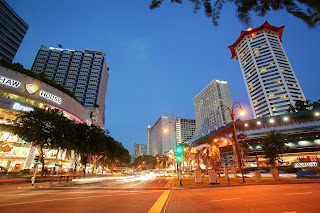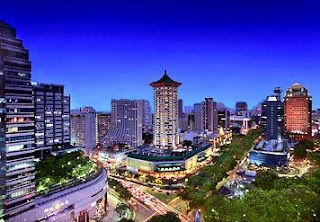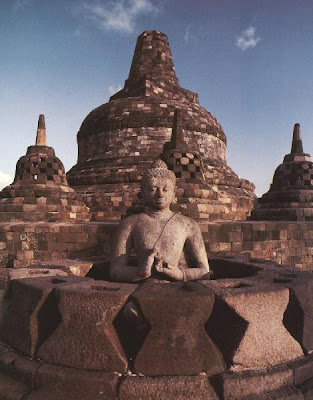Langkawi’s islands and the adjacent beaches are a few of the most dazzling places in Southeast Asia in Malaysia. This is one of the finest places you can opt for picnic with your love. White sand gleaming in the glow of the stifling sun, pleased by the light wind as gulls and eagles wave in the skies, for sand and surf, which Langkawi has to offer.
This small island never wonder be celebrated the most excellent beaches among outing crazies. The beautiful sweeping seashore, sandy bays, warm water and its vegetation all leads to in a dreamy day.
These are the most popular tourism,worlds best tourism places. Here not just information about best tourism places of the world along with route to visit with cheap expenses.
Sunday, January 31, 2010
Saturday, January 23, 2010
Places to Visit,Places to See in Thailand,Tourist places
Ko Phi Phi is made up of two islands, Phi Phi Don with its endless beaches and Phi Phi Le, a private enclosed area girdled by sheer cliffs.
Previously (and still is) a temporary residence for sea gypsies, Ko Phi Phi has since turned into a favorite spot for diving lovers from all over the world. The coral reefs in the clear waters ensure a spectacular sighting and the colorful fishes swimming in their natural habitat is a sight to behold.
Previously (and still is) a temporary residence for sea gypsies, Ko Phi Phi has since turned into a favorite spot for diving lovers from all over the world. The coral reefs in the clear waters ensure a spectacular sighting and the colorful fishes swimming in their natural habitat is a sight to behold.
Situated 48 km from Phuket and 42 km from Krabi, the island is only accessible by boats. Tours to Phi Phi Le is commonly done on board kayaks where tour guides would take you to the Viking Cave, which is rich with its prehistoric paintings of things resembling Viking longboats. Most tours would include a visit to the cliffs where swiflets' nests are harvested for bird's nest soup, a Chinese delicacy throughout Asia.
Formally a quiet Muslim fishing village, Phi Phi Island now meets all touristy demands, including restaurants, diving schools, and hundreds of overpriced souvenir shops.
Krabi Tourism and Sightseeing,Places to see in Krabi
Krabi is a paradise for nature lovers and visitors who want to enjoy the beauty and diversity of a seaside holiday in a laid–back, casual atmosphere. You’ll find fantastic beaches backed by towering limestone peaks, lovely tropical islands scattered off the coast and colourful coral reefs for diving adventures. Located 800kms south of Bangkok, Krabi is one of Thailand’s most popular destinations.
Most of the attractions in the Krabi area are natural ones, and in fact you’ll find some of the most dramatic seascapes in the world here. We’ve listed some of the most popular attractions here, and suggest that you consult one of the free tourist maps for exact locations.
Tourist Attractions of Krabi:
Ao Nang beach
This is Krabi’s main resort area, comprising a long stretch of beach, half of which has a backdrop of striking karst cliffs and the other half lined with resorts and tourist amenities along the beachfront road. Ao Nang is quite pleasant and a relaxed spot to enjoy your holiday. It’s not overcrowded like Patong in Phuket, and has a far more natural feel, but you’ll have to wander along the beach to avoid the noisy longtail boats that come and go from this point. Sunsets here are particularly good, with offshore islands as a fitting Krabi Town
The small provincial capital that provides a glimpse into real Thai life. The town has largely escaped commercial tourism due to its lack of a beach, but it’s an interesting place to visit, having colourful markets, a pleasant walking path that follows the estuary mouth and lots of restaurants offering up local favourites, with seafood being a speciality
Railay Beach
Considered one of the most spectacular of all the Andaman coastal locations. This idyllic spot is a peninsula that canonly be reached by boat, as it’s separated from the mainland by sheer limestone cliffs. A few quiet resorts are situated between the two crescent–shaped beaches. In all, there are a number of beautiful beaches to choose from, but Phra Nang attracts most of the day–trippers as it features an ancient shrine inside a cave. Those who are fit can hike up a steep path to the top of the karst and gaze down into a hidden sinkhole lake in the middle
Koh Lanta Marine National Park
Home to Chai Leh, who are known in English as sea gypsies. They typically live in small settlements and are nomadic, earning a living from collecting shells and fishing. The Chai Leh have their own language and set of spiritual beliefs, which are animistic in nature.
At the northern and southern extremes of Koh Lanta, the mountains are covered by virgin rainforest. On the west coast, there are numerous beaches that are wonderfully situated and also heavily developed but in a natural way, such as Khlong Dao, Khlong Khong, Khlong Nin and Phra Ae, providing views of spectacular seascapes. Along the western side and at the northern tip near Laem Kho Kwang, you’ll find coral reefs. Also at the northern tip’s Saladan pier, there are banks, shops, eateries and tour operators
Thursday, January 21, 2010
Hongkong Accomodation Best Palace Victoria Peak
Victoria Peak: High above Hong Kong Island on the 'back of the Dragon', Victoria Peak is Hong Kong's premier visitor attraction, providing magnificent harbour and city views. Arriving late afternoon enables you to experience the dazzling panorama of Hong Kong Island, the harbour, Kowloon and the hills beyond. Later, you can thrill to the neon-dotted skyline by night. What's more, The Peak offers visitors a multitude of fantastic entertainment, dining and shopping options.
Wednesday, January 20, 2010
Popular Places to Visit in Paris
Who doesn’t know Paris? A city that is almost always associated to romance, love and adventure.
What to see in Paris? Wow, lots of things. The most famous sites are: The Eiffel Tower, The Museum of Louvre, The Museum of Orsay, The Montparnasse Tower, The Notre Dame of Paris, The Sacré Coeur Basilica, Avenue of Champs Elysées, Garden of Luxembourg, Garden of Tuileries, The Versailles Palace and garden, La Defense, Center of Georges Pompidou,… and lots of other big sites
But choose your own places, according to what you like and to what interests you. Let me give you additional tips for your visit in Paris:
* To save some budget, avoid using taxi. Use the Metro and RER service (the subway of Paris), or the bus. But due to the traffic, I’d rather take the Metro. You can find Metro stations everywhere, but always watch your bags, watches, or cell phones!
* You can ask for free the map of Metro and bus lines everywhere! But preferably ask for it when you arrive in Paris in the airport… You can also ask for it in the Metro stations, some big department stores (for example Galeries Lafayette), etc…
* Learn a little French before coming… Just some little useful expressions to say: how do you do, how much does it cost, I would like some water, etc… It will be very useful!
* I know that Paris sounds glamorous… But just bring your comfortable clothes (according to the season), comfortable shoes (girls, our high heels are not made for the streets in Paris), one or two formal clothes if you want to watch opera or ballet, and you’re ready!
* What to eat??? Hah, welcome to France my friend. Try and dare your self to eat French food. If you’re afraid to wrong-order, ask the waiter first what it is. One suggestion, if you go to restaurants, ask for ménu, which doesn’t means the menu card, but a meal consisted of entry, main menu, and a dessert. Usually it’s cheaper to buy ménu than to eat à la carte, which means to choose one by one the entry, the main menu, and the dessert from the menu card/book. If you want to save some budget, try French famous sandwiches, or pizza, or Kebab (sandwich from Turki), or panini (sandwich from Italia), or the famous French crêpes!
Tuesday, January 19, 2010
Taj Mahal Building in India
The Taj Mahal base structure is a large, multi-chambered structure. The base is essentially a cube with chamfered edges and is roughly 55 meters on each side (see floor plan, right). On the long sides, a massive pishtaq, or vaulted archway, frames the iwan with a similar arch-shaped balcony. On either side of the main arch, additional pishtaqs are stacked above and below. This motif of stacked pishtaqs is replicated on chamfered corner areas as well. The design is completely symmetrical on all sides of the building. Four minarets, one at each corner of the plinth, facing the chamfered corners, frame the tomb. The main chamber houses the false sarcophagi of Mumtaz Mahal and Shah Jahan; their actual graves are at a lower level.
The marble dome that surmounts the tomb is its most spectacular feature. Its height is about the same size as the base of the building, about 35 meters, and is accentuated as it sits on a cylindrical "drum" of about 7 metres high. Because of its shape, the dome is often called an onion dome (also called an amrud or guava dome). The top is decorated with a lotus design, which serves to accentuate its height as well. The shape of the dome is emphasised by four smaller domed chattris (kiosks) placed at its corners. The chattri domes replicate the onion shape of the main dome. Their columned bases open through the roof of the tomb and provide light to the interior. Tall decorative spires (guldastas) extend from edges of base walls, and provide visual emphasis to the height of the dome. The lotus motif is repeated on both the chattris and guldastas. The dome and chattris are topped by a gilded finial, which mixes traditional Persian and Hindu decorative elements. The main dome is crowned by a gilded spire or finial. The finial, made of gold until the early 1800s, is now made of bronze. The finial provides a clear example of integration of traditional Persian and Hindu decorative elements. The finial is topped by a moon, a typical Islamic motif, whose horns point heavenward. Because of its placement on the main spire, the horns of moon and finial point combine to create a trident shape, reminiscent of traditional Hindu symbols of Shiva.
The exterior decorations of the Taj Mahal are among the finest to be found in Mughal architecture. As the surface area changes, a large pishtaq has more area than a smaller one, and the decorations are refined proportionally. The decorative elements were created by applying paint or stucco, or by stone inlays or carvings. In line with the Islamic prohibition against the use of anthropomorphic forms, the decorative elements can be grouped into either calligraphy, abstract forms or vegetative motifs.
The interior chamber of the Taj Mahal steps far beyond traditional decorative elements. Here the inlay work is not pietra dura, but lapidary of precious and semiprecious gemstones. The inner chamber is an octagon with the design allowing for entry from each face, though only the south garden-facing door is used. The interior walls are about 25 metres high and topped by a "false" interior dome decorated with a sun motif. Eight pishtaq arches define the space at ground level. As with the exterior, each lower pishtaq is crowned by a second pishtaq about midway up the wall. The four central upper arches form balconies or viewing areas and each balcony's exterior window has an intricate screen or jali cut from marble. In addition to the light from the balcony screens, light enters through roof openings covered by chattris at the corners. Each chamber wall has been highly decorated with dado bas relief, intricate lapidary inlay and refined calligraphy panels, reflecting in miniature detail the design elements seen throughout the exterior of the complex. The octagonal marble screen or jali which borders the cenotaphs is made from eight marble panels. Each panel has been carved through with intricate pierce work. The remaining surfaces have been inlaid with semiprecious stones in extremely delicate detail, forming twining vines, fruits and flowers.
Monday, January 18, 2010
Travel to Disneyland Park at Paris
Disneyland Paris Park is a theme park which is a part of Disneyland Resort Paris. Operated by Euro Disney S.C.A., it is one of two theme parks in the complex just outside of Paris, in Marne-la-Vallée, France.
The park is based on a concept pioneered by Disneyland in California and further employed at the Magic Kingdom in Florida and Tokyo Disneyland in Japan. Occupying 566,560 m² (140 acres), it is the largest Disney park based on the original in California. The park opened as Euro Disneyland on 12 April 1992.
The park, as well as its surrounding complex, initially failed to meet financial expectations. This resulted in an image change in which the word "Euro" was phased out of several names, including Euro Disneyland.
The park is based on a concept pioneered by Disneyland in California and further employed at the Magic Kingdom in Florida and Tokyo Disneyland in Japan. Occupying 566,560 m² (140 acres), it is the largest Disney park based on the original in California. The park opened as Euro Disneyland on 12 April 1992.
The park, as well as its surrounding complex, initially failed to meet financial expectations. This resulted in an image change in which the word "Euro" was phased out of several names, including Euro Disneyland.
Sunday, January 17, 2010
Luxury Orchard Road Singapore
Today, Orchard Road is brimming with upscale eateries, swanky Singapore hotels, and luxurious shopping malls from one end all the way to the other with no respite. Some of the stores in Singapore are older, more unique shops along Orchard Road, or areas that barely escaped demolition as with the ones near Emerald Hill. This ultra famous and favored shopping hub is situated among a number of ritzy Singapore hotels like the Four Seasons, the Shangri-La, and the Mandarin, and for a very good reason! There are plenty of visitors who skip the sights and hit the shopping circuit with fervor and relentlessness.
Centrepoint is by far the best-known mall for retails shops in Singapore and also the largest. The many stores inside, including celebrated Robinsons & Co, offer something for everyone. Electronics, clothing, fine arts, antiques, books, jewelry, and much more serve as some of the most popular items up for grabs. Fast food and a nice array of restaurants offer places to eat and ponder over your new acquisitions. Perhaps the second most favored is Tanglin Shopping Center along Orchard Road. Carpet shops are a big draw and feature beautiful large and smaller handmade rugs from Afghanistan, Persia, and Pakistan. Along with specialty carpets there is a wide assortment of tailors to choose from. Antique prints and maps along with special Japanese pearls are other favorite items.
On Orchard Road Singapore malls also include The Hereen and Far East Plaza. The Hereen offers some of the best dining of all the shopping malls including sumptuous Thai fare, Japanese food, Peranakan delights, and even Swiss cuisine. Many quirky, off-the-wall items, and unusual finds are in store as well as vintage and street clothing, accessories and many other fashion finds. A medley of fashion, jewels, music, electronics, and more all with a unique twist are up for grabs at Far East Plaza. Both expats and locals favor Far East Plaza for unrivaled choices and prices.
Centrepoint is by far the best-known mall for retails shops in Singapore and also the largest. The many stores inside, including celebrated Robinsons & Co, offer something for everyone. Electronics, clothing, fine arts, antiques, books, jewelry, and much more serve as some of the most popular items up for grabs. Fast food and a nice array of restaurants offer places to eat and ponder over your new acquisitions. Perhaps the second most favored is Tanglin Shopping Center along Orchard Road. Carpet shops are a big draw and feature beautiful large and smaller handmade rugs from Afghanistan, Persia, and Pakistan. Along with specialty carpets there is a wide assortment of tailors to choose from. Antique prints and maps along with special Japanese pearls are other favorite items.
On Orchard Road Singapore malls also include The Hereen and Far East Plaza. The Hereen offers some of the best dining of all the shopping malls including sumptuous Thai fare, Japanese food, Peranakan delights, and even Swiss cuisine. Many quirky, off-the-wall items, and unusual finds are in store as well as vintage and street clothing, accessories and many other fashion finds. A medley of fashion, jewels, music, electronics, and more all with a unique twist are up for grabs at Far East Plaza. Both expats and locals favor Far East Plaza for unrivaled choices and prices.
Friday, January 15, 2010
Exotic Burj Al Arab Dubai Hotel
Dubai hotels and resorts are well known around the world for the great service and their excellent facilities. No where else in the world can hotel guests receive such Royal treatment and enjoy so many outstanding facilities. Dubai beach resorts are simply spectacular. The beach resorts in Dubai are located along the crystal white sands of the Jumeirah beach area and no words can describe the beauty of this section of Dubai. Dubai resorts are notoriously expensive which comes as no shock when looking at the quality of product that guests receive in return. There are however ways to obtain much lower rates at the Dubai resorts. This allowed for many tourists visiting Dubai who normally could not afford a Dubai resort to stay at one of the Dubai beach resorts. Of course we will offer you advice on how to get rates so that you can afford one of the spectacular Dubai beach hotels. Please look in our Dubai resort section for additional information on how to get cheap Dubai hotels in Deira and Bur Dubai and beach resorts in the Jumeirah beach area.
Thursday, January 14, 2010
Travel to Borobudur Temple In Magelang Yogyakarta Indonesia
Borobudur temple is a ninth-century Mahayana Buddhist monument in Magelang, Central Java, Indonesia. The monument comprises six square platforms topped by three circular platforms, and is decorated with 2,672 relief panels and 504 Buddha statues. A main dome, located at the center of the top platform, is surrounded by 72 Buddha statues seated inside perforated stupa.
The name 'Bore-Budur', and thus 'BoroBudur', is thought to have been written by Raffles in English grammar to mean the nearby village of Bore; most candi are named after a nearby village. If it followed Javanese language, the monument should have been named 'BudurBoro'. Raffles also suggested that 'Budur' might correspond to the modern Javanese word Buda ('ancient') – i.e., 'ancient Boro'. However, another archaeologist suggests the second component of the name ('Budur') comes from Javanese term bhudhara (or mountain).
Approximately Borobudur Location 40 kilometers (25 mi) northwest of Yogyakarta, Borobudur is located in an elevated area between two twin volcanoes, Sundoro-Sumbing and Merbabu-Merapi, and two rivers, the Progo and the Elo. According to local myth, the area known as Kedu Plain is a Javanese 'sacred' place and has been dubbed 'the garden of Java' due to its high agricultural fertility. Besides Borobudur, there are other Buddhist and Hindu temples in the area, including the Prambanan temples compound. During the restoration in the early 1900s, it was discovered that three Buddhist temples in the region, Borobudur, Pawon and Mendut, are lined in one straight line position.
It might be accidental, but the temples' alignment is in conjunction with a native folk tale that a long time ago, there was a brick-paved road from Borobudur to Mendut with walls on both sides. The three temples (Borobudur–Pawon–Mendut) have similar architecture and ornamentation derived from the same time period, which suggests that ritual relationship between the three temples, in order to have formed a sacred unity, must have existed, although exact ritual process is yet unknown
The name 'Bore-Budur', and thus 'BoroBudur', is thought to have been written by Raffles in English grammar to mean the nearby village of Bore; most candi are named after a nearby village. If it followed Javanese language, the monument should have been named 'BudurBoro'. Raffles also suggested that 'Budur' might correspond to the modern Javanese word Buda ('ancient') – i.e., 'ancient Boro'. However, another archaeologist suggests the second component of the name ('Budur') comes from Javanese term bhudhara (or mountain).
Approximately Borobudur Location 40 kilometers (25 mi) northwest of Yogyakarta, Borobudur is located in an elevated area between two twin volcanoes, Sundoro-Sumbing and Merbabu-Merapi, and two rivers, the Progo and the Elo. According to local myth, the area known as Kedu Plain is a Javanese 'sacred' place and has been dubbed 'the garden of Java' due to its high agricultural fertility. Besides Borobudur, there are other Buddhist and Hindu temples in the area, including the Prambanan temples compound. During the restoration in the early 1900s, it was discovered that three Buddhist temples in the region, Borobudur, Pawon and Mendut, are lined in one straight line position.
It might be accidental, but the temples' alignment is in conjunction with a native folk tale that a long time ago, there was a brick-paved road from Borobudur to Mendut with walls on both sides. The three temples (Borobudur–Pawon–Mendut) have similar architecture and ornamentation derived from the same time period, which suggests that ritual relationship between the three temples, in order to have formed a sacred unity, must have existed, although exact ritual process is yet unknown
Subscribe to:
Posts (Atom)





+-+Koh+Phi+Phi+islands+2.jpg)






























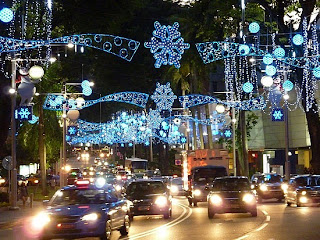

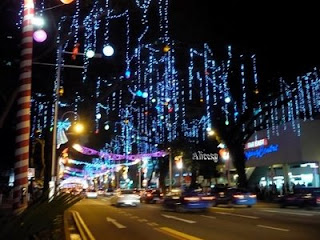
.jpg)
